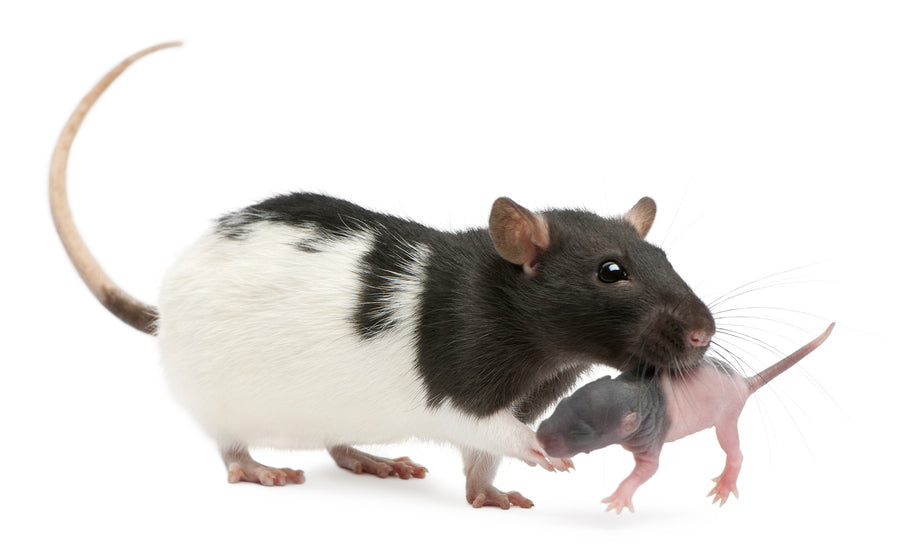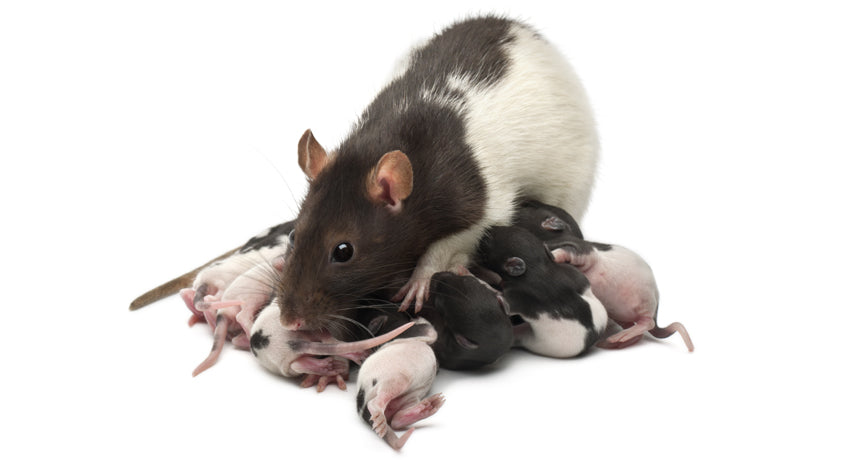- Genetically, they are very similar to humans, sharing 85% and 90% of human coding genome for mice and rats respectively (3, 4). Almost every known disease-related gene in humans has a counterpart in mice and rats, making it possible to replicate and study human conditions and diseases.
- Mouse and rat anatomy and physiology are also very similar to humans, allowing researchers to compare and study complex biological systems (such as the reproductive, digestive, immune, nervous, cardiovascular and skeletal systems!).
- They are relatively small with a 25g average weight for a mouse and about 10 times bigger at 300g for rats. They are convenient to house, easy to care for, and economical to maintain.
- They have a short life span, helping to understand much more quickly the progression of diseases or the aging process.
- They also have a short generation interval, relatively large litters, and reproduce fast, expanding to large study cohorts rather quickly. However, many breeding challenges can occur. The Animal Welfare Act and the 3Rs are a set of regulations and guidelines that veterinarians, scientists and animal care-takers follow to keep the animals in good health and minimize their distress.
Important Nutrients for Fertility
The breeding cycle and reproduction pattern of rats and mice are very similar, with some slight differences. Rats reach sexual maturity around 8-10 weeks of age for females and 10-12 weeks of age for males. As for mice, females are mature at about 4-6 weeks of age and males at 6-8 weeks of age. Breeders are then usually retired at 6-8 months of age for mice and 9-12 months of age for rats. There are many factors that can influence fertility: advanced age for both males and females (5), stress from the environment, such as noise (6), abnormal light cycles, temperature (7), and undernutrition or obesity. Specifically, some nutrients are highly involved in male and female fertility:
- A diet low in protein has been shown to reduce male fertility (8).
- Vitamin B12 (cobalamin) and B9 (folic acid) have a positive impact on sperm count, motility, morphology and DNA stability (9, 10). In females, folic acid has been shown to increase progesterone and promote ovulation (11).
- Omega-3 fatty acids have been shown to improve oocyte quality (12) and increase sperm density and sperm motility (13).

DietGel Prenatal contains 51.1 mcg of folate and 2.2 g of omega-3s per 100g of gel!
REQUEST YOUR FREE SAMPLE NOW!
Breeding Schemes for Mice and Rats
Mating, i.e. putting males and females together in a cage, usually can start occurring around 6 weeks of age for mice and 10 weeks of age for rats. Different mating schemes can be used in both species:
- Pair (1 female + 1 male) - indicated when you need to track genetic transmission and specific parental lines.
- Trio (2 females + 1 male) - suited to grow an inbred or GEM colony to produce more animals. Trios do not maintain pedigree, as it does not allow for identifying the dam for each pup.
- Harem (3-5 females + 1 male) - typically used only for mice, not rats. While it is a convenient scheme when space is limited, cages can become overcrowded rapidly!
- Rotation (1 male rotated weekly between different female cages) - appropriate when the number of breeding males is limited.
- Continuous (leaving males and females together in the breeding cage at all time), in opposition to non-continuous mating (the male is removed just before or just after the litter is born) - continuous mating takes advantage of the fertile postpartum estrus that occurs within 48 hours of giving birth (14), before the female goes back to anestrus until the pups are weaned
- Burst (mating many males with many females on the same day) - if a single large cohort of same age mice/rats is required for a study, a careful 5 step preparation is needed:
- Know the number of mice needed in the specific genotype.
- Calculate the number of total pups needed.
- Then calculate the total number of breeders needed, knowing the average litter size for your strain.
- Housing the breeding females all together at first will suppress the estrus cycle and females will go into anestrus (Lee-Boot effect).
- Finally, mate all the breeding units the same day: when those females are exposed to male pheromones, estrus is induced (Whitten effect - in mice only) maximize the number of pregnancies (15).
We recommend using DietGel® Prenatal in your breeding cages at least from mating (as soon as the male and female are put together in a cage) to weaning (when the pups are removed from the parental cage), changing the cup 3 times a week (i.e. Monday, Wednesday, Friday).
References:
(1) Why use the mouse in research?
(2) Why are mice considered excellent models for humans?
(3) Why Mouse Matters
(4) Rat genome unveiled
(5) Paternal age affects fertility and progeny outcome in the Brown Norway rat
(6) Effect of noise stress on male rat fertility, and the protective effect of vitamins C and E on its potential effect
(7) Effect of heat stress on the fertility of male mice in vivo and in vitro
(8) The effect of dietary protein intake on factors associated with male infertility
(9) Estimation of folic acid/micro nutrients levels; Does it reflect sperm parameters
(10) Low folate in seminal plasma is associated with increased sperm DNA damage
(11) The impact of dietary folate intake on reproductive function in premenopausal women: a prospective cohort study
(12) Prolonging the female reproductive lifespan and improving egg quality with dietary omega-3 fatty acids
(13) Effect of different dietary omega-3/omega-6 fatty acid ratios on reproduction in male rats
(14) Rat Breeding Colony Management - McGill
(15) Management of Research Animal Breeding Colonies
Image from (16)




Leave a comment
All comments are moderated before being published.
This site is protected by hCaptcha and the hCaptcha Privacy Policy and Terms of Service apply.